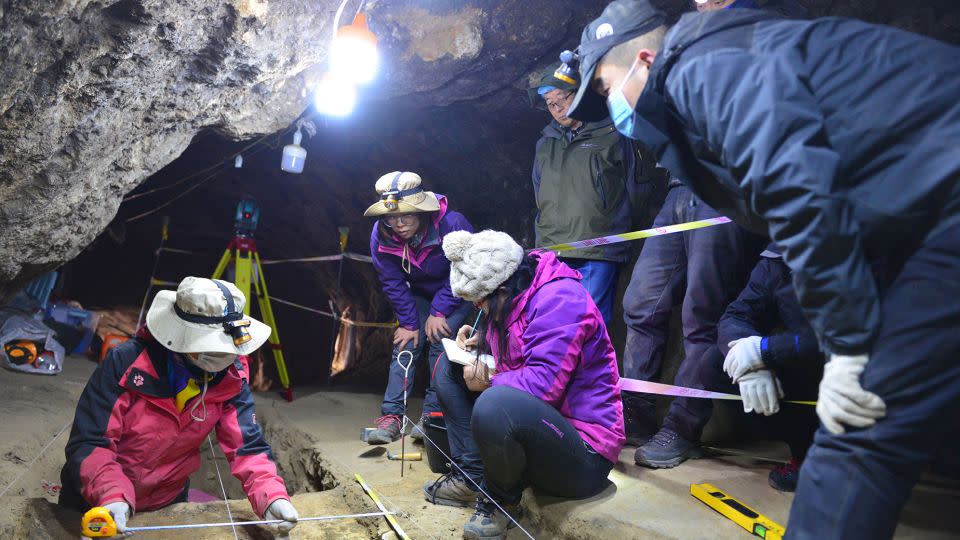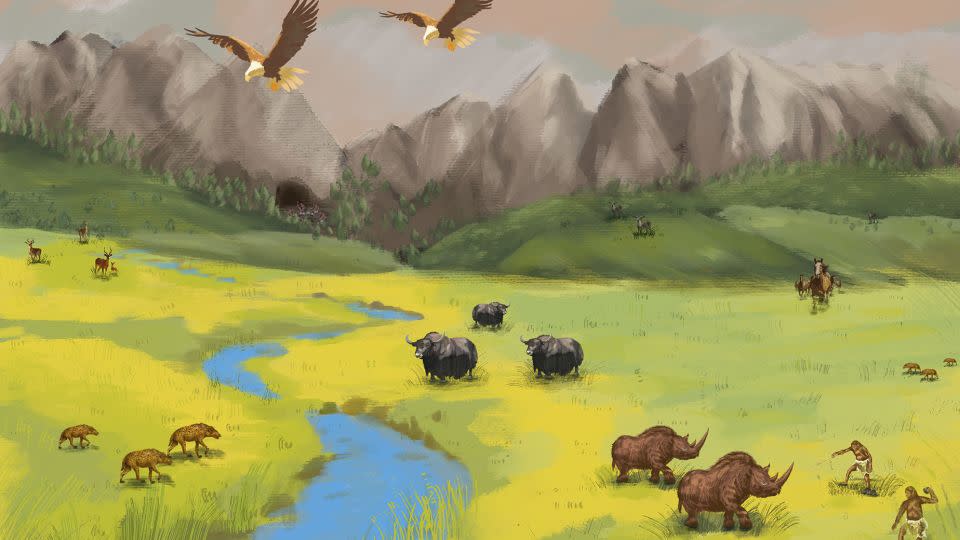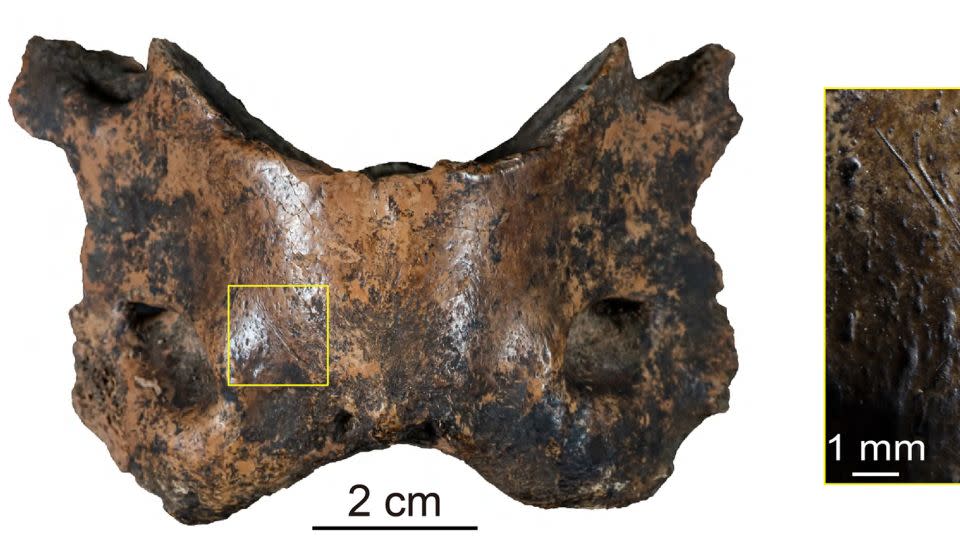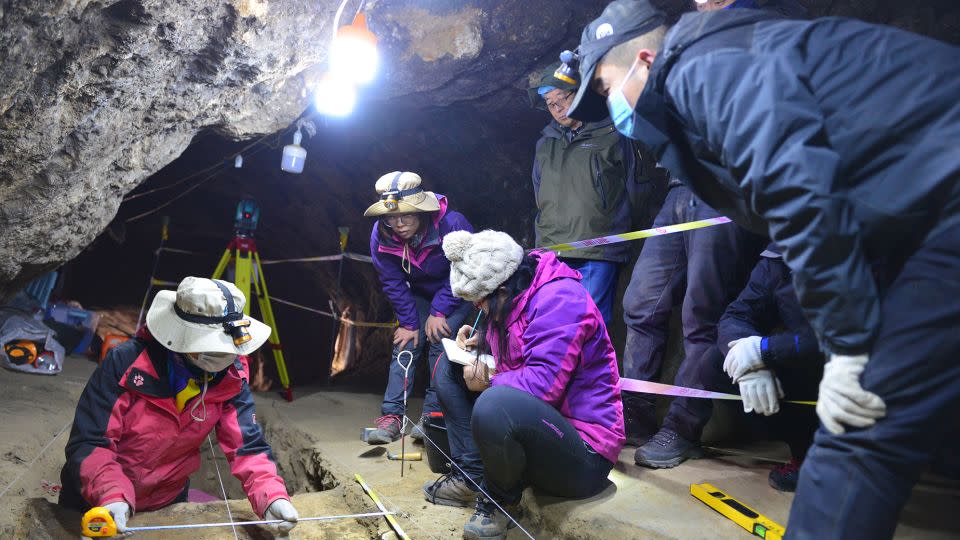Sign up for CNN’s Wonder Theory science newsletter. Explore the universe with news on fascinating discoveries, scientific advancements and more.
Denisovans survived and thrived on the high-altitude Tibetan plateau for more than 100,000 years, according to a new study that deepens scientific understanding of the enigmatic ancient humans first identified in 2010.
Researchers analyzed thousands of animal bone fragments unearthed at Baishiya Karst Cave, 3,280 meters above sea level near the city of Xiahe in China’s Gansu province — one of only three places the extinct humans were known to have lived. Their work revealed that Denisovans could hunt, butcher and process a range of different large and small animals, including woolly rhinos, blue sheep, wild yaks, marmots and birds.
The team of archaeologists working at the cave also uncovered a rib bone fragment in a layer of sediment that dates back between 48,000 and 32,000 years, making it the youngest of the handful of known Denisovan fossils — a clue that the species was around more recently than scientists previously thought.
Due to a dearth of fossil evidence, details on how these archaic human ancestors lived have been scarce. But the new study reveals Denisovans who lived in Baishiya Karst Cave were incredibly resilient, surviving in one of Earth’s most extreme environments during warmer and colder periods and maximizing the diverse animal resources available in the grassland landscape.
“We know that the Denisovans lived, occupied the cave and this Tibetan plateau for such a long time, we really want to know, how did they live there? How did they adapt to the environment?” said Dongju Zhang, an archaeologist and professor at Lanzhou University in China and co-lead author of the study published Wednesday in the journal Nature.
“They used all these animals available to them, so that means their behavior is flexible,” Zhang added.
The rib belonged to Denisovan who likely lived at a time when modern humans were dispersing across the Eurasian continent, said study coauthor Frido Welker, an associate professor at the Globe Institute’s Biomolecular Paleoanthropology Group at the University of Copenhagen. He said future research at the site and in the region could shed light on whether the two groups interacted there.

“It does put this fossil and the (sediment) layer in a context where we know in the wider region humans were likely to be present, and that’s interesting,” he said.
A trail of Denisovan clues
Denisovans were first identified little more than a decade ago in a lab using DNA sequences extracted from a tiny fragment of finger bone. Since then, fewer than a dozen Denisovan fossils have been found worldwide.
Most of those were found in Denisova Cave in the Altai Mountains of Siberia, which is how the group got their name. Genetic analysis subsequently revealed that the Denisovans, like Neanderthals, had once interbred with modern humans. Traces of Denisovan DNA found in present-day people suggest the ancient species likely once lived across much of Asia.
However, it wasn’t until 2019 that researchers identified the first Denisovan fossil from outside the namesake cave.
A jawbone with teeth found by a monk at Baishiya Karst Cave, a holy place for Tibetan Buddhists, dated back at least 160,000 years and contained a Denisovan molecular signature. The discovery of DNA from sediment at the site, published a year later, provided more evidence that Denisovans had once called the area home.
In 2022, scientists identified a tooth unearthed at a cave in Laos as Denisovan, a clue that placed the species in Southeast Asia for the first time. As with the jawbone, DNA could not be extracted from the tooth, so researchers instead studied the microscopic remnants of proteins, which preserve better than DNA, although they are less informative.
The study published Wednesday examined more than 2,500 bits of animal bone retrieved during excavations at Baishiya cave in 2018 and 2019.
Most of the fragments were too small to be identified by eye, so the researchers turned to a relatively new technique known as Zooarchaeology by Mass Spectrometry (ZooMS), which allows scientists to extract valuable information from specimens that might have been overlooked in the past.
Based on small differences in the amino acid sequence of collagen preserved inside the bone, ZooMS helped the researchers determine to which type of animal the bones belonged.

Baishiya’s place in the Denisovan story
As well as large and small herbivores, the analysis revealed carnivores like hyenas. Some of the animals, such as the blue sheep, are still common in the Himalayas today.
Many of the bones had cut marks that showed the Denisovans were processing the animals for their hides as well as meat and bone marrow. Some bones were also used as tools, according to the study.
Together, the diversity of animal species found suggests the area around the cave was dominated by a grass landscape with some small forested areas — similar to today, although Zhang noted most of the animals living there in present day are domesticated yaks and goats.
During the laborious process of categorizing the bones, which took several months, the team identified the rib bone fragment, which is 5 centimeters long. However, the resolution of the protein information wasn’t clear enough to immediately determine what kind of human it had belonged to. Further analysis of the preserved ancient proteins led by Welker revealed it was Denisovan.
The rib bone came from a layer of sediment from which the team had previously extracted Denisovan DNA, and Zhang said the researchers are trying to recover DNA from the new specimen. That process could provide more detailed genetic information about the rib’s owner and the wider Denisovan population that once lived in the area.

With so little information about the Denisovans, “each discovery is of major importance” and the zooarchaeological analysis carried out by the new study’s authors was “particularly insightful,” said archaeological scientist Samantha Brown, a Junior Group Leader for Palaeoproteomics at Germany’s University of Tübingen who has worked on remains from Denisova Cave.
“The young age of the fossil was definitely surprising. At this time period we have evidence for modern humans occupying sites all the way (to) Australia. This really opens up conversations about the possibility of those groups interacting as modern humans moved into Asia and the Pacific but more evidence will likely be needed to understand the nature of those interactions,” Brown, who was not involved in the research, said.
Work continues at Baishiya Karst Cave, and Zhang is excavating another paleolithic site in the region that Denisovans or the modern humans who came after them might have occupied, she said.
Unlike Denisova Cave, which was occupied by early modern humans and Neanderthals as well as Denisovans, current evidence suggests that Denisovans were the only group of humans to live at Baishiya Karst Cave, Zhang said. That makes the Tibetan plateau — an area nicknamed “the roof of the world” — a particularly significant locale in the quest to answer the many remaining questions about who the Denisovans were, what they looked like, how they disappeared and their place on the human family tree.
For more CNN news and newsletters create an account at CNN.com
EMEA Tribune is not involved in this news article, it is taken from our partners and or from the News Agencies. Copyright and Credit go to the News Agencies, email news@emeatribune.com Follow our WhatsApp verified Channel





